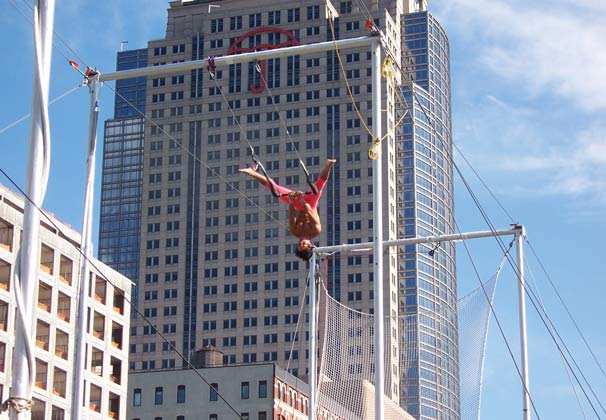
For many, April is a month of overwhelming work schedules and daydreams of summer vacation. Exercise routines often take a backseat, but squeezing in a little “me time” can go a long way toward rebooting the mind, relieving stress and renewing inspiration. Take a couple of hours this week to consider the world from a new perspective and accept a unique mental and physical challenge at one of New York City’s outdoor flying trapeze schools.
Flying trapeze is no longer an activity enjoyed only by circus performers and gymnasts. Facilities like Trapeze School New York make it accessible to any brave soul in the metropolitan area. The sport leaves even the fittest athletes sore after their first flying lesson. Like yoga and pilates classes, trapeze sessions challenge every abdominal and back muscle of the body’s core as flyers stabilize their bodies and control each minor movement when they shift from one position to another. The arms and shoulders share in the workout as well, connecting the body to the swinging bar and supporting the flyer as he or she leaps from the raised platform into the air.
Regardless of the workout factor, the most compelling part of flying trapeze is the adrenaline rush that continuously floods the body during the two-hour long lesson. It is as much about the mental challenge as it is the physical one. Learning to trust your body and its abilities, relinquishing control as you soar through the air and taking in the world around you from an entirely different vantage point develops strength far more useful in life than activities like power-lifting in a gym ever could.
TSNY operates two outdoor trapeze school locations in Manhattan, challenging artists, athletes and adrenaline junkies alike to test their personal limits and learn how to fly. Trapeze students take in iconic views of New York City from Pier 40 near Hudson River Park, a site just a short walk from the heart of the NYU campus, to Pier 16 at the South Street Seaport. Professionals teach classes with a 10-person limit in state-of-the-art facilities and keep the experience as safe, hands-on and interactive as possible.
If the idea of abandoning solid ground for two hours still leaves you more anxious than excited, opt for a trampoline class instead. Focusing on flips rather than flying will enable a participant to improve body awareness, challenge core muscles and work on timing for tricks that will come in handy when giving the trapeze a whirl.
Flying trapeze classes last for two hours and range from $50 to $70. Introductory and beginner trampoline classes last 60 to 90 minutes and cost $35, and intermediate classes cost $65.
A version of this article appeared in the Monday, April 15 print edition. Alena Hall is a contributing columnist. Email her at [email protected].






















































































































































